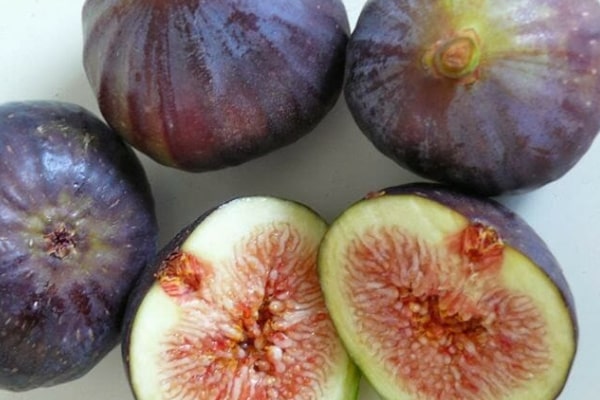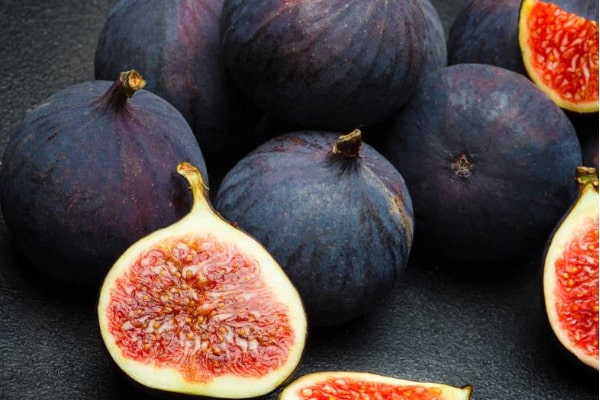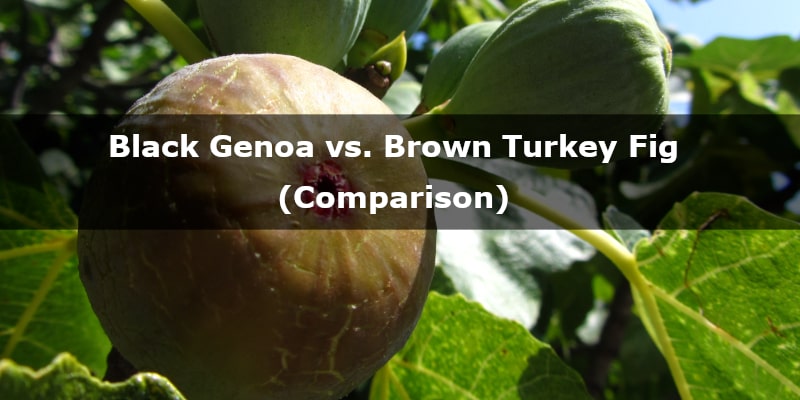If you are a fan of figs, you must be familiar with the multiplicity of fig types. The Black Genoa and the Brown Turkey fig are two of the most popular types of figs.
In this article, I will compare Black Genoa vs. Brown Turkey figs regarding their taste, texture, size, appearance, and nutritional value.
By the end of this article, you should have a better idea of which type of fig is right for you.
Black Genoa Fig: at a Glance
Commercial fig producers are diehard fans of the Black Genoa fig tree species, which is valued for its distinct flavor and superior storage capacity. When ripe, it has a squat, pear shape and a dark purple color. It is a fruitful tree with a higher yield than other types.

Its fruit is harvestable between March and April. It spreads naturally, has an open growth habit, and eventually becomes a beautiful shade tree.
Due to its attractive crop of fresh, juicy figs, Black Genoa is also an excellent choice for a specimen tree in your garden.
Brown Turkey Fig: at a Glance

Brown Turkey is a short tree with thin foliage, which means it is definitely not a shade tree. The fruit of this plant is large, shaped like a pear, and has visible, deep ribs and few seeds. It turns a purplish brown, but the stem end is a little lighter.
If you reside in a coastal area, you can discover that the fruit has lost some sweetness after being exposed to extended periods of heavy rain.
Because of this, the Brown Turkey fig tree flourishes well in Perth and is better suited to drier inland places. Besides, it produces one harvest per year.
Taste, Texture, Color
The Black Genoa fig has a deep, rich flavor that is perfect for baking and cooking. The skin of the Black Genoa is dark purple, and the flesh is a deep red. It is also one of the largest figs, so it is perfect for making jams and preserves.
On the other hand;
The Brown Turkey fig has a lighter, sweeter flavor perfect for eating fresh. The brown turkey fig has more tart and acidic taste. Its skin is golden brown, and the flesh is a pale yellow. This fig is smaller than the Black Genoa, so it is perfect for snacking on.
Fruit Size
The Black Genoa is a large fig, with around 4 inches. The brown turkey fig is smaller, with a diameter of about 2.5 inches.
The Black Genoa is a round fruit with dark black skin. It has an orange center with hard, thick, and shiny skin.
The Brown Turkey fig is a large fruit that can be used as an alternative to a grapefruit. It has brown skin with a light orange inside.
Related: How Long Does Fig Tree Live? (Explained)
Health Benefits and Nutritional Value
Both of these fig types have a lot of health and nutritional benefits. The Black Genoa contains iron, Vitamin A, and C. While Brown Turkey contains minerals like potassium and irons. Along with Vitamin B6 and E.
The Black Genoa has a high nutritional value. A 3.5-ounce serving contains 26% of the daily value for iron, 5% of vitamin A, and 4% of vitamin C.
On the other hand, the Brown Turkey fig contains many minerals, such as potassium, iron, and magnesium.It also has vitamins B6 and E. 3.5-ounce servings contain 25% of the daily value for potassium, 3% for iron, and 4% for vitamin B6.
Both fruits are high in anthocyanin antioxidants, which are linked to a reduced risk of cancer and heart disease.
Price
On average you can expect to pay about $1.50 per fig for Black Genoa. On the other hand, Brown Turkey is priced slightly lesser than that.
The Black Genoa fig is a widespread variety of figs coveted for its sweet taste and dark color. This fig is typically more expensive than other varieties, such as the brown turkey fig.
You must know that the price of the Black Genoa fig can vary depending on the time of year and the region where it is grown.
Tree Appearance
The Black Genoa fig tree is an evergreen tree that can grow up to 30 feet (9 m) tall. The tree has a dark brown to black trunk and branches. The tree’s leaves are large, dark green, and glossy. Besides, it produces small, black fruits that are edible and have a sweet taste.
On the other hand;
The brown turkey fig tree can grow up to 20 feet (6 m) tall. Similar to Black Genoa, it has a brown trunk, large, dark green, and glossy leaves. The tree produces small, brown fruits that are edible and have a sweet taste.
Related: Violette de Bordeaux Fig vs. Black Mission (Compared)
Feeding
When choosing a fertilizer for your fig tree, make sure that it contains all the essential nutrients that fig trees need: nitrogen (N), phosphorus (P), and potassium (K). Fig trees are heavy feeders and will benefit from being fertilized regularly.
There are a few things to keep in mind when it comes to feeding these trees. The Black Genoa fig tree is a heavy feeder, so it must fertilize the tree regularly to ensure healthy growth and fruit production. The Brown Turkey fig tree is slightly more tolerant of poor soil conditions, but still benefits from regular fertilization.
Organic feeding methods, such as composting, are always the best for fig trees (and all plants). Both varieties produce abundant fruit, making them an excellent choice for those who want fresh figs in their diet.
However, if you cannot manage organic feeding, you can go for organic fertilizers such as Jobe’s Fertilizer Spikes (buy it here). It is easy to apply and potentially harmless compared to other high NPK ration fertilizers.
Tree Maintenance and Care
Both, the Black Genoa and the Brown Turkey fig require special care and attention. Tree maintenance is essential to keep these trees healthy and enjoy a high yield.
The Black Genoa tree sheds its leaves in the fall and winter. It is crucial to provide the tree with a little more care during these seasons.
However, the Brown Turkey fig is an evergreen, which means it keeps its leaves all year. It makes it easier to care for, but you’ll still need to keep an eye on it for diseases.
Here are some tips on how to care for these trees:
- Water the trees regularly, deep water them at least once a week.
- Fertilize the trees twice a year, in the spring and fall.
- Prune the trees regularly to remove dead or diseased branches.
- Inspect the trees regularly for signs of pests or diseases.
By following these simple tips, you can ensure that your Black Genoa and brown turkey fig trees will stay healthy and look great for years to come.
Tip: Run a soil test before planting fig trees. If the soil pH is low, you can use Jobe’s Additive De-Acidifier (buy it here) to prepare the soil for fig trees. It will prevent the plant from numerous problems, such as poor fertilizer response, and contribute to healthy yield.
Harvesting
The first step in harvesting these figs is to shake the tree gently and loosen the fruit to make it easier to pick. Next, you must pick the figs. They should be placed in a basket or container so they do not get damaged. Once the figs are picked, they need to be sorted.
Harvesting figs is a delicate process that must be done with care. The fruit is very soft and can easily be damaged.
The best time to harvest figs is in the late summer or early fall after the fruits have ripened. If you live in a warm climate, your figs may be ready to harvest as early as July.
To check if your figs are ripe, gently squeeze the fruit; if it yields to pressure, it is ready to pick. Figs can be eaten fresh off the tree or stored in the refrigerator for up to a week.
Black Genoa: Pros and Cons
Pros
- Excellent source of fiber, vitamins, and minerals
- High water content
- Unique, sweet taste that many people enjoy.
- Easy to find
- Relatively expensive
Cons
- Contain a lot of sugar
- Not ideal for people with diabetes
- Susceptible to root rot
- Figs can attract wasps
Brown Turkey: Pros and Cons
Pros
- Used as an Ornamental plant
- Best for skin and hair health
- Use for making oil
- Affordable
Cons
- Easily attacked by insects
- Only grow in coastal areas
Black Genoa vs. Brown Turkey Fig: Which Variety Should You Plant?
Both types have unique flavors and textures, so deciding the best might be difficult. However, the rich flavor and sweet taste of Black Genoa are unmatchable. Choosing Black Genoa for your home garden would be the best decision for you.
On the other hand, the Brown Turkey fig is also an excellent choice if you’re looking for a fig that is a bit more tart. This variety is also smaller, so it’s perfect for gardens with limited space.
Nutritionally, both types of figs are a good source of fiber and vitamins A and C. They also contain a decent amount of calcium. Ultimately, it’s up to you to decide which variety would become a part of your pretty garden.
References
Ultimatebackyard.com plants.ces.ncsu.edu trees.com plantogram.com Diggers.com specialitytrees.com gardeningknowhow.com

